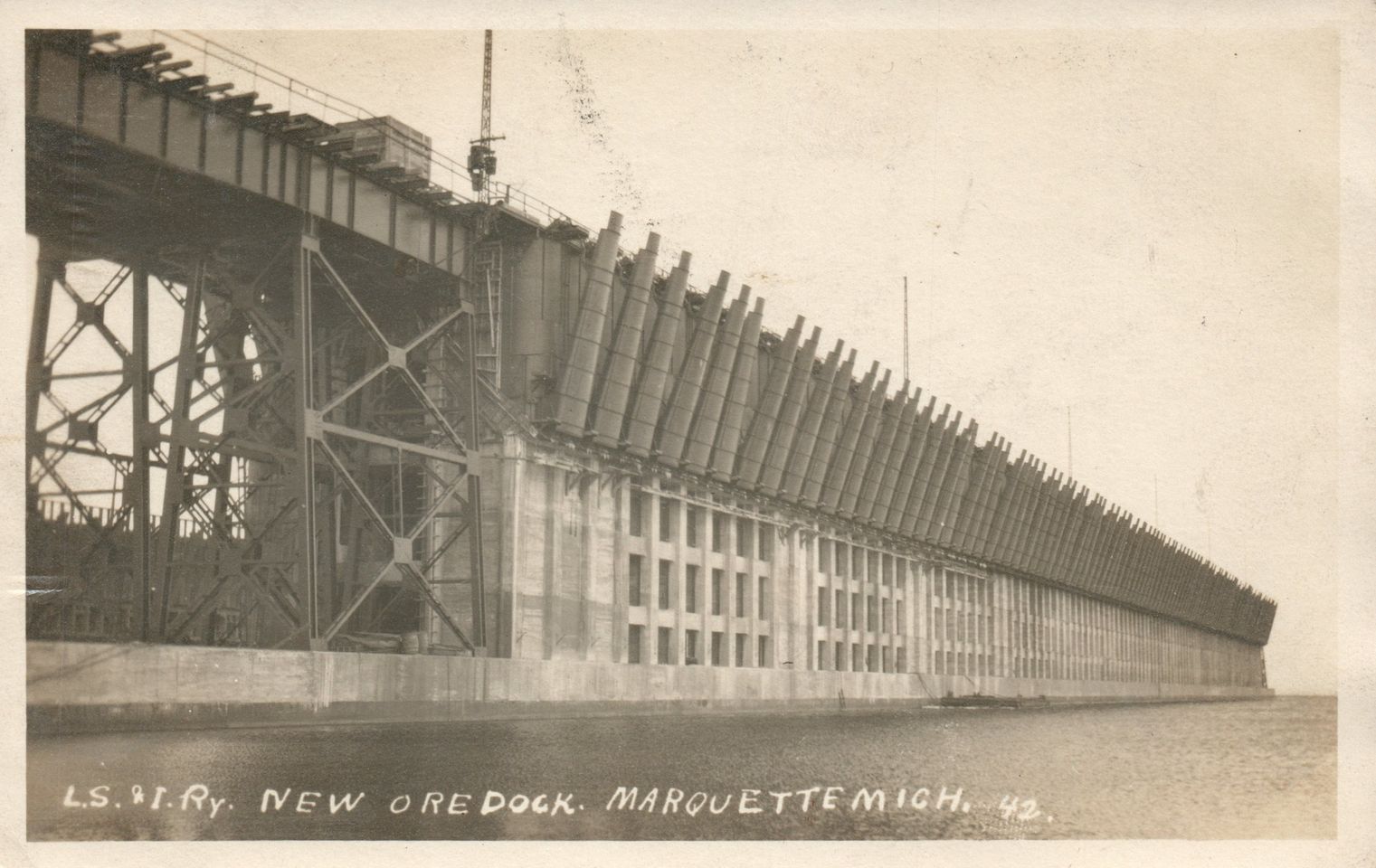- Details
- Hits: 1093
Location: Presque Isle, MI - 1912 LS&I Concrete Dock
Type: Concrete and steel dock with single approach.
Built: 1912
Operated for 110 years (as of 2022), continues
Owner: Lake Superior & Ishpeming railroad
Length: 1,200 feet
Height Above Water: 75 feet.
Pockets: 200 pockets
Ended: Currently in use.
 Image info: A photo of the new LS&I ore dock shortly after it was placed into operation.
Image info: A photo of the new LS&I ore dock shortly after it was placed into operation.
Notes
Concrete Ore Dock. The LS&I ore dock was built in 1912 and replaced a timber dock which was built nearby in 1896. The reinforced concrete dock was designed by J. F. Jackson, vice president of the Wisconsin Bridge and Iron Company of Milwaukee. His firm elected the steel superstructure while the reinforced concrete substructure, designed by R. C. Young, the chief engineer of the LS&I railroad was built by the Raymond Concrete Pile Company. At the time, this was the second reinforced concrete dock built in the United States, completed a year after a similar dock by the Great Northern railway at Superior, Wisconsin.
Overall, it is 1,200' long, 54' wide and 75' above the water. There are 200 ore pockets of 250 ton capacity yielding a total storage capacity of 50,000 tons. Each pocket has a 12' center and is equipped with a pair of doors, each 5' tall and 3' 8" wide, opening into a steel chute 35' long and weighing 8,200 lbs. The chutes utilized a novel design intended to prevent the ore from sticking to the chute or overflowing its confines. They were designed with curved bottoms and were tapered from 8' 6" wide at the upper end to 4' 6" at the lower end, which was inserted into the bulk ore carrier. [UPM]
Approach. The approach to the ore dock was designed by the railroad's chief engineer, R. C. Young with virtually all work carried out by railroad employees. It consists of an earth embankment one mile long with a 1.5% grade, connected to the dock by a steel trestle 600' long and 70' in height. The base of the embankment was constructed by the Zenith Dredge Company of Duluth, using the material dredged from the harbor to form the slips for the dock. The base utilized approximately 109,000 cubic yards of hydraulically-filled dredging's. Work on the embankment proper began on April 3, 1911 and was completed on January 15, 1912. Crews moved a total of 503,000 cubic yards of sand from a pit one and one-half miles away using trains of 25 side-dump cars. [UPM]
When ore is frozen in rail cars, two heating houses are used, each capable of thawing 56 cars at a time. When ore/pellets have frozen inside the ore dock, the LS&I uses two cars equipped with Vapor Clarkson steam generators. One car is a rebuilt tender from a steam locomotive and the other is a flat car with a large water tank mounted on the car and a steam generator on one end. Both cars must be used with a 1,000 hp Alco road switcher, requiring their electrical power. The cars can be steamed up in 15 minutes, compared to two or more hours for steaming up a steam locomotive. Both of these cars are used on the LS&I and loaned to the nearby Soo Line ore dock in Marquette. [LSIOR-1969]
Time Line
1911. January. Plans for the highest ore dock in the world are under way here at Marquette. It will be built by the LS&I railroad company at a cost of $1.2 million. The dock will be built of reinforced concrete and will be one of the largest on the lakes. [LSJ-0121]
1912. March. Concrete work on the LS&I railroad's big new ore dock at Marquette, which was suspended for the winter in November, will be resumed next week when William McMenimen, superintendent for the Raymond Concrete Pile Co., Chicago and New York, will arrive from Duluth with 200 men. The dock will be finished by next August. [LSJ-1912-0325]
1912. New dock is constructed, replacing a smaller wooden dock.
1917. The DSS&A railroad has announced that the big docks in this city will be closely guarded, as a measure of precaution in case of war. From these docks is shipped a large part of the iron ore from the Marquette range. The LS&I railroad docks on Presque Isle are being closely guarded also. [LSJ-1917-0404]
Bibliography
The following sources are utilized in this website. [SOURCE-YEAR-MMDD-PG]:
- [AAB| = All Aboard!, by Willis Dunbar, Eerdmans Publishing, Grand Rapids ©1969.
- [AAN] = Alpena Argus newspaper.
- [AARQJ] = American Association of Railroads Quiz Jr. pamphlet. © 1956
- [AATHA] = Ann Arbor Railroad Technical and Historical Association newsletter "The Double A"
- [AB] = Information provided at Michigan History Conference from Andrew Bailey, Port Huron, MI

